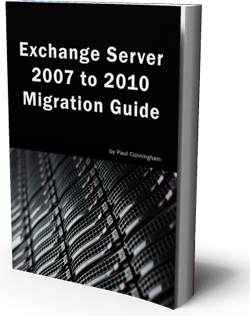 I’m pleased to announced the release of the Exchange Server 2007 to 2010 Migration Guide.
I’m pleased to announced the release of the Exchange Server 2007 to 2010 Migration Guide.
Exchange Server 2010 is a big evolutionary step from previous versions of Exchange. I’ve delivered successful Exchange 2010 migration projects involving thousands of mailboxes. And I’ve been called in to bring customers’ migration projects back from the brink of disaster too.
The Exchange Server 2007 to 2010 Migration Guide brings together my knowledge and experience in Exchange Server migrations so that you can avoid disaster and celebrate a successful project outcome.
In the Exchange Server 2007 to 2010 Migration Guide you get:
- The migration guide itself, a 250+ page PDF with detailed, step by step instructions that take you through the entire process of migrating to Exchange Server 2010
- A planning worksheet to record the important information you need from your existing environment for a successful migration project
- A testing worksheet so you know that your new Exchange 2010 servers are working correctly before you put them into production
- BONUS: Guide to Exchange Server 2010 Backup and Recovery, to help you protect your servers from data loss
Here’s what Exchange Server expert Steve Goodman wrote in his review of the Exchange Server 2007 to 2010 Migration Guide:
From a brief read, I can tell this is a book based on real world experience. It covers the kind of things I get asked time and time again and see people stuck with on forums. There are more comprehensive volumes out there on Exchange, covering a lot more topics in a lot more detail, but where I think this book stands out is it’s the guide a lot of small to medium business admins tackling an Exchange migration themselves need to get the job done without much (or even any) help.
Click here to find out more and get your copy of the Exchange Server 2007 to 2010 Migration Guide.



HI paul ,
Will it also give the information of what will be the difference from the user(client) side ?
will it also provide hardware recommendations?
just want verify all this cause i’m actually preparing for a presentation, this includes business requirements as well as a solution design. The solution design must contain the overall email architecture.
thanks Paul, hope to hear from you soon, so i can buy this already 🙂
Hi Earljon, I guess the key here is that it is a migration guide that covers the migration process itself, not a design guide. Giving specific design or hardware recommendations becomes difficult because every environment and business are different in so many ways.
What I’ve found is that a lot of customers struggle to perform the actual migration itself, so that is the focus with this guide.
You can read more detail about the topics covered here:
https://www.practical365.com/exchange-2007-2010-migration-guide
As for the user differences, the users can be completely unaware that the Exchange server has been upgraded if they are continuing to use the same Outlook version as before. Outlook 2010 users will see some new things like Mail Tips, but nothing significant. OWA is different, but I don’t cover those differences in detail.
However the guide does focus a lot on delivering a migration project that is as non-disruptive as possible for the end users. Its nice when the end users have no complaints during and after a migration has happened 🙂
Hope that helps.
Are you going to create an ePub version as well?
Hopefully yes. Working on Kindle format, ePub format, and print editions of both my guides.
very cool, thanks!